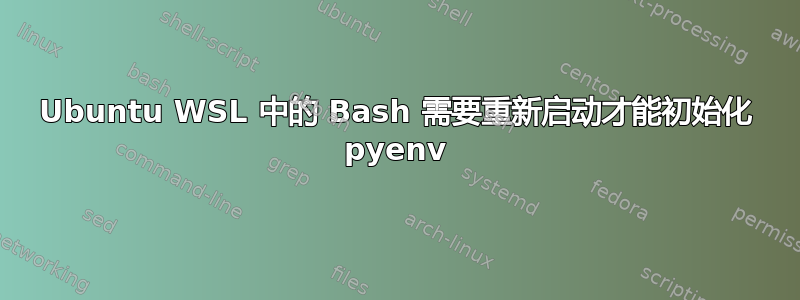
我在 WSL 上的 Ubuntu 20.04 中遇到了一个小但非常奇怪的 pyenv 问题。当我启动 shell 然后尝试激活虚拟环境时,我遇到了与此处所述相同的问题:https://stackoverflow.com/questions/45577194/failed-to-activate-virtualenv-with-pyenv?newreg=6d05e39c69f747f1aa0665f00ed129b7
但是我已经按照中所述设置了 ~/.bashrc文档,如果我使用 virtualenv 重新启动 shell,exec $SHELL则它可以正常工作。这让我觉得 ~/.bashrc 由于某种原因在打开新窗口时没有执行,但我检查了一下,显然是这样。我使用 Homebrew 安装了 pyenv 和 pyenv-virtualenv。
为什么新打开的 shell 不会加载 virtualenv,但重新启动后会加载?
# ~/.bashrc: executed by bash(1) for non-login shells.
# see /usr/share/doc/bash/examples/startup-files (in the package bash-doc)
# for examples
# If not running interactively, don't do anything
case $- in
*i*) ;;
*) return;;
esac
# don't put duplicate lines or lines starting with space in the history.
# See bash(1) for more options
HISTCONTROL=ignoreboth
# append to the history file, don't overwrite it
shopt -s histappend
# for setting history length see HISTSIZE and HISTFILESIZE in bash(1)
HISTSIZE=1000
HISTFILESIZE=2000
# check the window size after each command and, if necessary,
# update the values of LINES and COLUMNS.
shopt -s checkwinsize
# If set, the pattern "**" used in a pathname expansion context will
# match all files and zero or more directories and subdirectories.
#shopt -s globstar
# make less more friendly for non-text input files, see lesspipe(1)
[ -x /usr/bin/lesspipe ] && eval "$(SHELL=/bin/sh lesspipe)"
# set variable identifying the chroot you work in (used in the prompt below)
if [ -z "${debian_chroot:-}" ] && [ -r /etc/debian_chroot ]; then
debian_chroot=$(cat /etc/debian_chroot)
fi
# set a fancy prompt (non-color, unless we know we "want" color)
case "$TERM" in
xterm-color|*-256color) color_prompt=yes;;
esac
# uncomment for a colored prompt, if the terminal has the capability; turned
# off by default to not distract the user: the focus in a terminal window
# should be on the output of commands, not on the prompt
#force_color_prompt=yes
if [ -n "$force_color_prompt" ]; then
if [ -x /usr/bin/tput ] && tput setaf 1 >&/dev/null; then
# We have color support; assume it's compliant with Ecma-48
# (ISO/IEC-6429). (Lack of such support is extremely rare, and such
# a case would tend to support setf rather than setaf.)
color_prompt=yes
else
color_prompt=
fi
fi
if [ "$color_prompt" = yes ]; then
PS1='${debian_chroot:+($debian_chroot)}\[\033[01;32m\]\u@\h\[\033[00m\]:\[\033[01;34m\]\w\[\033[00m\]\$ '
else
PS1='${debian_chroot:+($debian_chroot)}\u@\h:\w\$ '
fi
unset color_prompt force_color_prompt
# If this is an xterm set the title to user@host:dir
case "$TERM" in
xterm*|rxvt*)
PS1="\[\e]0;${debian_chroot:+($debian_chroot)}\u@\h: \w\a\]$PS1"
;;
*)
;;
esac
# enable color support of ls and also add handy aliases
if [ -x /usr/bin/dircolors ]; then
test -r ~/.dircolors && eval "$(dircolors -b ~/.dircolors)" || eval "$(dircolors -b)"
alias ls='ls --color=auto'
#alias dir='dir --color=auto'
#alias vdir='vdir --color=auto'
alias grep='grep --color=auto'
alias fgrep='fgrep --color=auto'
alias egrep='egrep --color=auto'
fi
# colored GCC warnings and errors
#export GCC_COLORS='error=01;31:warning=01;35:note=01;36:caret=01;32:locus=01:quote=01'
# some more ls aliases
alias ll='ls -alF'
alias la='ls -A'
alias l='ls -CF'
# Add an "alert" alias for long running commands. Use like so:
# sleep 10; alert
alias alert='notify-send --urgency=low -i "$([ $? = 0 ] && echo terminal || echo error)" "$(history|tail -n1|sed -e '\''s/^\s*[0-9]\+\s*//;s/[;&|]\s*alert$//'\'')"'
# Alias definitions.
# You may want to put all your additions into a separate file like
# ~/.bash_aliases, instead of adding them here directly.
# See /usr/share/doc/bash-doc/examples in the bash-doc package.
if [ -f ~/.bash_aliases ]; then
. ~/.bash_aliases
fi
# enable programmable completion features (you don't need to enable
# this, if it's already enabled in /etc/bash.bashrc and /etc/profile
# sources /etc/bash.bashrc).
if ! shopt -oq posix; then
if [ -f /usr/share/bash-completion/bash_completion ]; then
. /usr/share/bash-completion/bash_completion
elif [ -f /etc/bash_completion ]; then
. /etc/bash_completion
fi
fi
# add files to path
alias atom="/mnt/c/Windows/System32/cmd.exe /c 'atom'"
if command -v pyenv 1>/dev/null 2>&1; then
eval "$(pyenv init -)"
eval "$(pyenv virtualenv-init -)"
fi
答案1
调用 shell 的方法有多种。当您使用终端模拟器(例如启动 WSL 时)或通过 SSH 登录系统时,此类 shell 称为登录 shell。您启动并向其中键入命令的任何 shell,无论它是否也是登录 shell,都称为交互式 shell。非交互式 shell 是用于编写脚本或以其他方式不向其中键入命令的任何 shell。
当您启动 WSL 时,这是一个登录 shell,但当您运行exec bash或 时exec $SHELL,这是一个非登录交互式 shell。我怀疑如果您在启动 WSL 后立即运行,您会看到同样的问题exec $SHELL -l,WSL 会启动登录 shell,而不是非登录交互式 shell。
对于 bash,~/.bashrc不会读取不是来自 SSH 的登录 shell;~/.bash_profile被读取。由于您不想重复配置,因此通常会在其中添加类似内容来~/.bash_profile阅读:~/.bashrc
# include .bashrc if it exists
if [ -f ~/.bashrc ]; then
. ~/.bashrc
fi
这将使您~/.bashrc在第一次启动 WSL 时被阅读,并且您的 virtualenv 代码应该正常工作。
答案2
我遇到了一个不同的问题,也需要重新启动 WSL2 才能使一切正常工作。
解决方案是禁用Windows 快速启动。
显然,有时在快速启动期间,WSL (default)被初始化而不是WSL2
您可以在下面禁用它“电源选项”>“选择电源按钮的功能”>“关机设置”>“开启快速启动”


